Do-it-yourself installation of a satellite dish: detailed instructions for installing and setting up a satellite dish
Satellite dishes in recent years have somewhat lost their relevance to society. The reason is the appearance on the market of digital TV set-top boxes. Nevertheless, this equipment remains in demand, and especially if the population lives outside the urban zone.
It is not a problem to purchase equipment, but installing a satellite dish may well become a serious task with an independent approach to installation. However, the task can be greatly facilitated if you have basic knowledge. We will talk about how the installation is performed using the example of the popular Tricolor system.
The content of the article:
Potential Master Concepts
Even if you deal with a traditional television antenna, and in such cases, installation requires at least minimal knowledge and skills. Satellite equipment is much more complicated in comparison with conventional TV reception.
If for conventional equipment there are two main concepts - cable and plug, a system where reception from the satellite is carried out has a number of technical concepts:
- TV satellite.
- Satellite Antenna
- Converter
- Multi-feed holder.
- Bracket.
- Receiver.
Let us consider in more detail each of the constituent elements of satellite equipment.
Tv satellite - The source of the signal to be received by the antenna. Accordingly, in order to receive a constant signal, a constant direction of the antenna to the satellite is necessary.
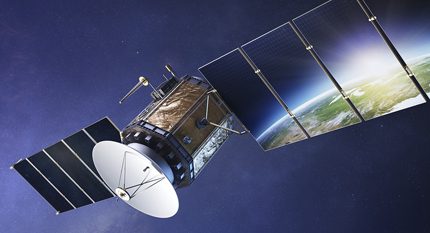
There are various satellites and different antenna designs, however, the tuning principle is almost the same for everyone.
For this technology of television reception, a satellite dish is used, which is a disk "plate" of different diameters, equipped with a conversion device - converter.
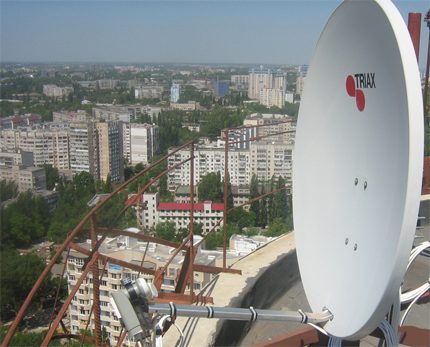
This is a module of small geometric dimensions, usually cylindrical in shape, attached directly to the "front" of the satellite dish.
The disk antenna has a special design, which allows not only to receive a television signal, but also to concentrate and direct it to one point - namely to the converter. It, in fact, is the primary signal amplifier, from which the signal is sent via cable to the receiver.
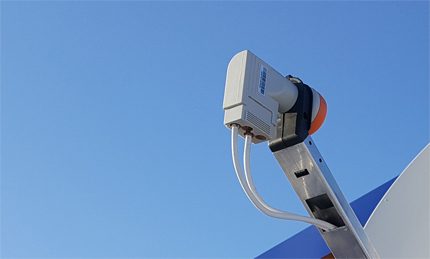
To fix the module, a special rod holder is used. Device called Multi-feed holder - This is the same holder bar, only slightly modified. Allows you to place multiple converters to work with different satellites.
An arm is, in fact, a mechanical structure that is assembled from component parts and fixed at the proposed installation site of the satellite dish. As a rule, such a place is the wall of the building, less often the roof rafter system.
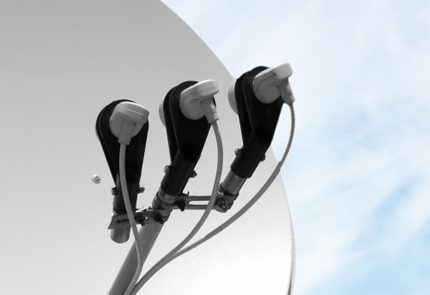
The electronic module for processing the received television signal, followed by the output of information on the screen of the television receiver, was called receiver.
There are various receiver designs depending on the manufacturer. However, a particular manufacturer, as a rule, completes the equipment taking into account the correspondence of the antenna and the apparatus.
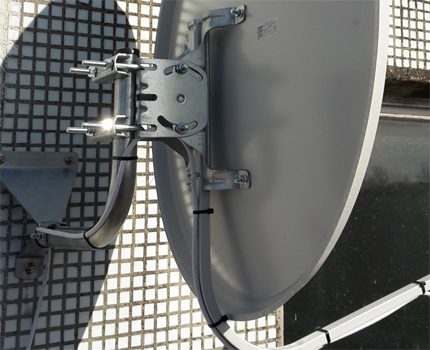
Therefore, any receiver (receiver) to coordinate with any non-native antenna is quite problematic. This point should be taken into account before installing it in the house with your own hands. satellite dish setup under the modern TV.
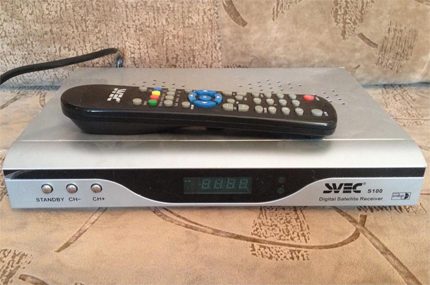
Choosing the right place for equipment
First of all, you should choose the optimal location of the satellite dish. What should be understood by the term "optimal"? Of course, a completely free area in the direction of the transmitting satellite.
That is, in a given direction excludes the presence of any objects like:
- buildings
- trees;
- advertising posters, etc.
It is also recommended to ensure the closest possible proximity of the rest of the equipment (receiver, TV) to the mounting point of the satellite dish. These are not critical requirements, but meeting these requirements will help simplify hardware setup.
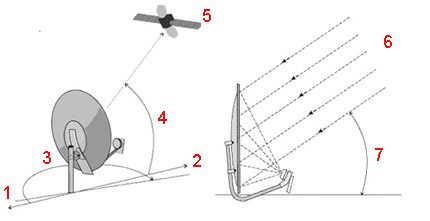
Traditionally, "plates" are placed on the wall of the building next to the window opening or installation is done on the side of the wall, which is part of the balcony (loggia) structure.
The instruction prohibits installation directly inside the balcony area, especially glazed.Equipment should also be installed at points where there is no possible rainfall in the form of snow and ice from the roof.
Step-by-step plate mounting instructions
First, it is necessary to complete the assembly of the satellite antenna structure as described in the attached instructions. As a rule, antennas are delivered unassembled. Therefore, the structure should be assembled using the supplied accessories.
Next, consider the step-by-step installation of a satellite dish.
Step # 1 - Antenna Bracket Mount
Again, given the work with a branded product, where all the installation elements and components are designed for the appropriate load, work is underway to install anchor bolts in the wall of the building.
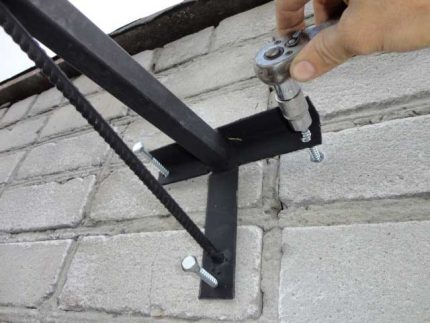
This work is done in a standard way, using a tool for working with concrete. After the introduction of the anchors, a support rod is mounted on the installed anchors, and a metal bracket is mounted on the rod.
Step # 2 - installing the antenna converter
Installation of the signal pre-amplifier - converter is carried out strictly according to the instructions, where all the subtleties of the placement of this component are noted.
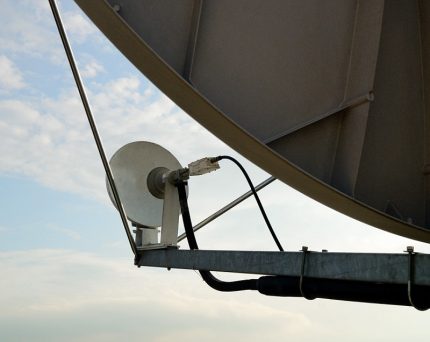
Step # 3 - connecting the cable to the converter
At the current stage, the cable, which is usually also included, is connected to the converter module. The connection is carried out using the supplied special connector “F”.
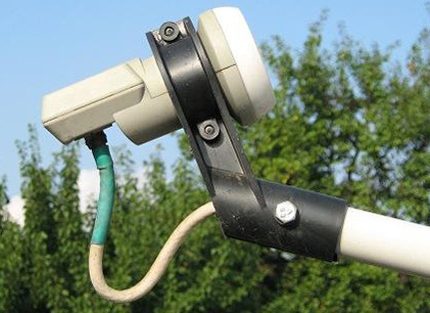
The connection area must be carefully sealed, for example with silicone sealant. The cable from the point of inclusion neatly and effortlessly stretches along the body of the converter holder bar. It is fixed at regular intervals with plastic ties or in another way.
Step # 4 - securing a satellite dish
The prepared “plate” is installed on the bracket, while the adjusting screws do not tighten all the way - they are left loosened.
This approach is necessary for the simple reason that further (after installation) the procedure for fine tuning to the satellite will follow. Accordingly, the "plate" will have to be moved both vertically and horizontally.
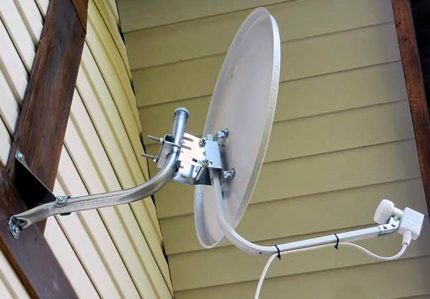
Separately, it is worthwhile to instruct on the installation of the F-connector on the coaxial cable. This operation has its own characteristics. The final area of the cable (approximately 15 mm long) must be freed from the first insulating layer.
But you need to remove the insulation taking into account the integrity of the screen braid present under the insulation layer. Then a second layer of insulation is removed over a length of about 10 mm. So the central copper core is freed. Next, a connector is screwed onto the stripped end-stop, passing the copper conductor into the corresponding hole.
How to configure the installed antenna?
Typically, the installation instructions of the "plate" contains a table where the information on the azimuth and angle is indicated - tuning parameters in the direction. Parameters are indicated, as a rule, for the area where large settlements are located.
You should select the nearby territory from the list and take the angle and azimuth parameters for the setting.Then, according to these parameters, set the antenna mirror, moving the "plate" in the vertical and horizontal planes.
This will be a “rough” setting. After which the antenna cable is connected to the receiver, and the receiver, respectively (also through the connecting cable) to the television receiver. Then it remains only to adjust the parameters of the angle and azimuth, achieving the highest quality picture on the TV screen.
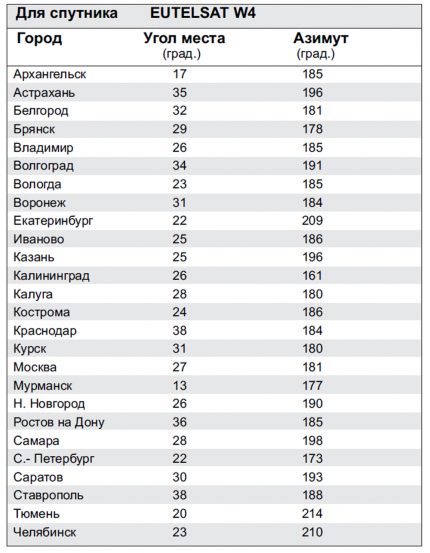
Any receiver by default has a service for monitoring the level of the received signal. Using this functionality, it is possible to fine-tune the equipment. However, weather conditions can make adjustments. Therefore, it is recommended to carry out tuning activities under the conditions of a clear cloudless sky.
Having achieved the appearance of a stable, sufficiently strong control signal on the TV screen, the nuts for fastening the mirror on the bracket are screwed to the stop. Equipment on this is considered installed and configured.
Next, they will proceed to normal user viewing using access cards or through free available channels. how tune tuner, select channels and open access - all this is in the user manual.
If a plate is installed in the country for regular viewing of television programs, the signal received by the antenna most often requires improvement due to the considerable remoteness of the repeater. In this situation will help antenna amplifier, whose selection rules will be introduced by our recommended article.
Conclusions and useful video on the topic
The video material is shown below, where the home master explains firsthand the details of the installation of the “plate”.
Accordingly, the whole process is filmed on a video camera, so the reader is clearly shown how to do the installation of a satellite dish with their own hands:
Despite the visible and invisible difficulties that appear in the process of installing a satellite “dish”, it is quite possible to do this job with your own hands. The main point is the meticulous collection, processing of relevant information and, of course, a careful study of the accompanying instructions.
Want to talk about how to install and configure a satellite dish with your own hands? Do you have information on the topic of the article, which is worth sharing with visitors to the site? Please write comments in the block below, ask questions, post photographs.

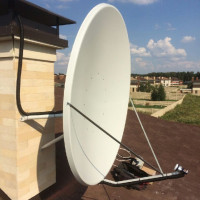 Do-it-yourself satellite dish tuning: do-it-yourself briefing on tuning the dish on the satellite
Do-it-yourself satellite dish tuning: do-it-yourself briefing on tuning the dish on the satellite  How to set up a satellite dish tuner yourself: equipment setup steps
How to set up a satellite dish tuner yourself: equipment setup steps 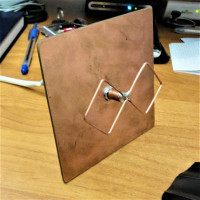 DIY TV antenna: step-by-step instructions for assembling popular TV antenna models
DIY TV antenna: step-by-step instructions for assembling popular TV antenna models 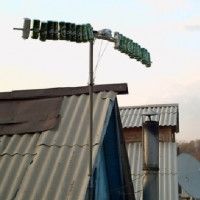 Do-it-yourself antenna for DIY: options and schemes for homemade products + manufacturing instructions
Do-it-yourself antenna for DIY: options and schemes for homemade products + manufacturing instructions 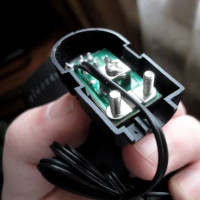 Antenna amplifier for a TV: the principle of operation and the rules for choosing a TV antenna amplifier
Antenna amplifier for a TV: the principle of operation and the rules for choosing a TV antenna amplifier 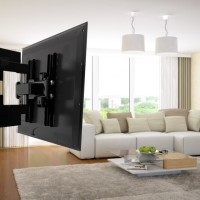 How to make a DIY TV bracket: popular homemade options
How to make a DIY TV bracket: popular homemade options  How much does it cost to connect gas to a private house: the price of organizing gas supply
How much does it cost to connect gas to a private house: the price of organizing gas supply  The best washing machines with dryer: model rating and customer tips
The best washing machines with dryer: model rating and customer tips  What is the color temperature of light and the nuances of choosing the temperature of the lamps to suit your needs
What is the color temperature of light and the nuances of choosing the temperature of the lamps to suit your needs  Replacement of a geyser in an apartment: replacement paperwork + basic norms and requirements
Replacement of a geyser in an apartment: replacement paperwork + basic norms and requirements
My parents live in the countryside. Since a stationary antenna catches 4-5 channels, we decided to purchase a satellite. Still, I want to keep abreast of all important events. Installation was carried out independently, the set included detailed configuration instructions. Do not just forget that such work is associated with height and electricity, and this poses a certain danger to life. If you have concerns, it is better to call the installers from the company where you purchased the equipment.
He put such a “plate” in the country. Most of all I carried with a signal amplifier (converter).After all, it’s not just necessary to fix the converter, but also to configure it. Why, then, a plate? It reflects the signal caught from space to the converter, and that one already transfers it via cable to the house, to the TV. If the converter is not ideally located in the center of the reflected beam, then the TV signal will be worse and weaker. So it is necessary to move it back and forth, catching that very central location. There is a longitudinal hole on the protruding pipe. Loosen the bolt with the nut that secures the converter and move its holder along this hole, thereby adjusting the location of the converter relative to the plate itself. We are guided by the signal strength on the receiver. It showed the maximum signal, which means that everything, stop, caught the optimal location. We tighten the bolt with the nut to the end and exhale)) Maybe something written will come in handy for someone.
The whole point is in azimuth - this is the angle at which the mirror of the antenna itself receives the signal from the satellites. And from the mirror of the antenna, the signal is reflected on the converter. To quickly select the azimuth to the desired satellites, I recommend using the application for smartphones Satellite Antenna Alignment. With it, you can quickly tune the antenna to receive a signal from satellites.
It is simple to do this: turn on the GPS, the application starts the camera and shows the direction (azimuth) in which there will be the best reception from satellites. I hope that this information will help not only you, but also other people who are faced with the problem of tuning the satellite dish.
I installed satellite dishes for myself and my friends. From my own experience I know that the most difficult moment is to correctly orient it to the desired satellite. Professional tuners use devices such as SatFinder, which determines the level of the received television signal. If you configure it yourself, it’s best to use some kind of portable TV with a small screen size, which can be installed directly next to the “plate” and then “catch” the desired satellite (as shown in the video). The most important thing is that first you need to correctly set the azimuth and elevation to the desired satellite, and there it will go.
I watched a bunch of videos before installing them in the house. Need one helper and all. It’s nothing difficult to assemble, but with setting the angle, here we were probably tormented for about 30 minutes until we caught a steady signal. There are literally a few mm to the side and not that.
It’s easier to install in your home. At first I stood in a city apartment, there I had to put it on the opposite side of the house with the help of a tower and call a professional tuner.